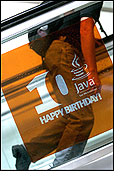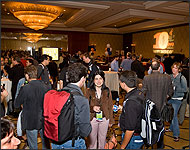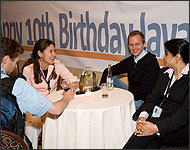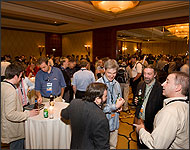
 About JCP
Get Involved
Community Resources
Community News
FAQ
Contact Us
About JCP
Get Involved
Community Resources
Community News
FAQ
Contact Us

|
 |
By Susan Mitchell
 Bigger, busier, and better. Having grown to well over 900 members, the Java Community
Process (JCP) program continues to thrive. More than 60 different entities -- including
corporations, open source groups, and individuals -- are now leading Java Specification
Requests (JSRs). Since the program started six years ago, 280 JSRs have been submitted and
many have been implemented into products ranging from cell phones to servers.
Bigger, busier, and better. Having grown to well over 900 members, the Java Community
Process (JCP) program continues to thrive. More than 60 different entities -- including
corporations, open source groups, and individuals -- are now leading Java Specification
Requests (JSRs). Since the program started six years ago, 280 JSRs have been submitted and
many have been implemented into products ranging from cell phones to servers.
All of that market-driven hustle and bustle translated into great fun at the 2005
JavaOne Conference held in San Francisco, California, celebrating the 10 year
birthday of Java technology. JCP program members took advantage of a variety of
opportunities to mingle with fellow members, Experts, Spec Leads, Executive Committee
(EC) members, representatives of other Java technology communities, and customers.
Spec Leads and EC members joined the PMO for a Spec Lead dinner held during the JavaOne
Conference. There was plenty of time for leisurely conversations over delectable
hors d'oeuvres, while various planned activities kept a pleasant momentum going.
Joshua Bloch and Neal Gafter were on hand to sign a complimentary copy of their new
book, Java Puzzlers. And Duke appeared for a brief time to greet and pose
for pictures with guests.
The pinnacle of the night was when attendees were introduced to the new Star Spec
Lead program. 16 Star Spec Leads were recognized,
several of whom were on hand to accept a personalized Waterman pen as a token of
appreciation for their excellent work.
The PMO looks forward to announcing additional Stars each quarter. Stars are selected by polling
Expert Group members, Executive Committee (EC) members, and PMO staff to identify those most effective
at ensuring a high quality output, figuring out better methods, and mentoring others. These are the folks
who communicate the best, respond the fastest, lead in a way that others will follow, set an appropriate pace,
sound a warning if schedule problems arise, and operate in and open and transparent way. Don't miss attendees comments on the Star Spec Lead program.
Another means of getting people to see the human face of the JCP program is through the annual
Java Communities in Action event, where members of many Java technology communities come together
for informal interaction. The JCP program, Jini technology, JXTA technology, java.net, and NetBeans
communities invited their constituents to interact during an evening event to encourage chat and cheer.
Two open bars and three international smorgasbord buffets of finger foods broke the room into cozy conversation spaces.
People began streaming in before the start time, and they continued to mingle long after the
event was expected to end. Guests quickly gathered into small talkative clusters that formed
and reformed repeatedly throughout the evening to accommodate the new people wandering in.
In all, over 650 community enthusiasts -- nearly double last year's number -- turned out for the festivities.
The birthday mood carried over into the Java Communities in Action event. The room, festooned
with orange, blue, and white balloons and birthday announcement posters, prompted guests to
reminisce about the early years. The crowd cheered the sudden guest appearance of Duke and
made good use of the photo opportunity to play around with Duke. Eventually, the candles on
two huge "Duke" and "10th birthday" cakes were lit, and the communities joined together in
singing the traditional birthday song and devouring the chocolate- and raspberry-filled cakes.
Early in the evening, the event host, Onno Kluyt, made it easy for guests to access
the different Java communities. Welcoming everyone to the event, he introduced the
leaders of each and pointed out where in the room the various communities could be found.
For the JCP program community, Onno's revelation of the five JCP program award winners
was a highlight of the evening. Selected by the Executive Committee based on performance over the past year,
each honoree received a beautiful clock framed in an upright, etched crystal plaque. Read more about the JavaOne 2005 Awards.
The standardization of such innovative Java technologies through the JCP program has become an
essential cornerstone for companies that implement it in their products. An anonymous representative
of one JCP member company relished the celebratory mood of the evening because it reflected the
appreciation of his employer for the "well-organized" JCP program. He says, "We're a member because
we like to see how the standards are developed. For Java technology to be a standard is an actual
success for us because products built on standards are more likely to be successful in the marketplace.
It's important to focus on customer needs."
 |
|
| Onno sings happy birthday to Duke. |
 |
Eugene Bogaart, a solution architect for Sun in The Netherlands, was also focused on customer needs.
Attending JavaOne for the ninth time, Eugene had accompanied 35 customers to this year's conference.
His compatriots, lead architect Gero Vermaas and Klaasjan Tukker, the Dutch Java User Group chairman,
claimed to have joined the party to meet Duke and see how Onno, also from The Netherlands, would behave.
As befits a global community, small enclaves around the room could be heard speaking Dutch, Portuguese,
and other languages. It's tempting to hang out with colleagues and friends, but the Brazilians of SouJava
decided it would be more worthwhile to focus outward and take advantage of the opportunity to make new
acquaintances.
For some people, JavaOne is all about attending lectures on the cutting edge, but for Marquart Franz,
JCP EC member representative for Siemens AG, networking is now his primary reason for attending.
He feels it is highly useful to interact with representatives of other companies in a friendly,
informal atmosphere.
The Java Communities in Action event is now in its third year, and veteran attendees know what they
want to do when they arrive. Marina Luwel works with JXTA technology, and she went directly to the
JXTA corner for a reunion with developers she now considers friends. On this night, she also enjoyed
meeting new people and developers in other Java communities. Marina is a lector at the XIOS Hogeschool
Limburg in Diepenbeek, Belgium.
 |
 |
 |
| Communities in Action crowd and conversations |
The JavaOne Conference also provided the opportunity to educate attendees on the JCP program. Nearly 25 members, experts and Spec Leads met Sunday to participate in a highly condensed five-hour training session with members of the JCP Program Office. Scheduling such an event just prior to the conference hadn't been tried before, but the training enjoyed great attendance and feedback.
The birds-of-a-feather (BOF) session #1102, "The JCP Program: How the Java Technology Binary Software Standard Is Managed and Evolves," provided an opportunity to hear about and discuss the program's:
- purpose, to provide binary standards that ensure compatibility
- outputs, of unambiguous JSRs, Reference Implementations (RI) that prove implementations are possible, and Test Compatibility Kit (TCK) to ensure compatibility
- process, of JSR submission, scheduling, and voting
- evolution of the process, tracked by a version number, to become more inclusive and transparent
- licensing issues and models, the Java Specification Participation Agreement (JSPA) that is signed by all members
The overall growth and enthusiasm exhibited by members of the JCP program during the JavaOne
community events reflect the continuing impact of last year's program upgrade to version 2.6.
The new emphasis on transparency and inclusion allows for "more channels for input, more voices
in the conversation" as characterized by Geir Magnusson Jr., which is already translating into faster
development of better specifications.
JCP Program Awards
Star Spec Lead program
2005 JavaOne Conference Home
The History of Java Technology
Sun.com JavaOne Feature Article
JCP Version 2.6 Anniversary
 . . . . . . . . . . . . . . . . . . . . . . . . . . . . . . . . . . . . . . . . . . . . . . . . . . . . . . . . . . . . . . . . . . . . . . . . . . . . . . . . . . . . . . . . . . . . . . . . . . . . . . . . . . . . . . . . |
 |
|